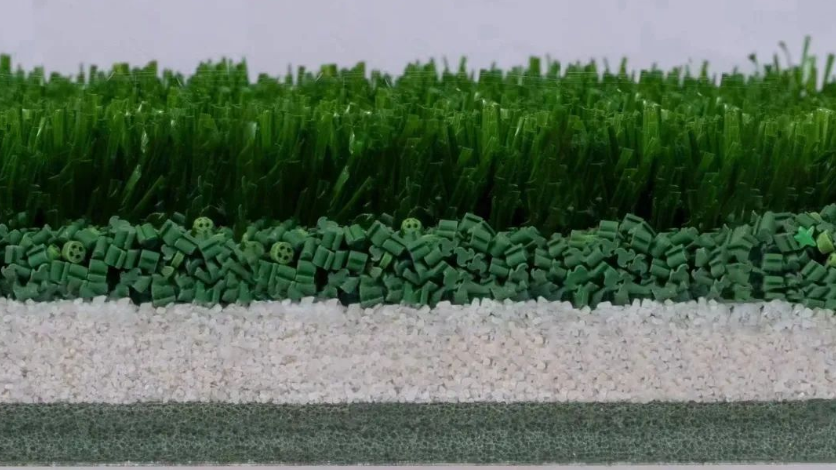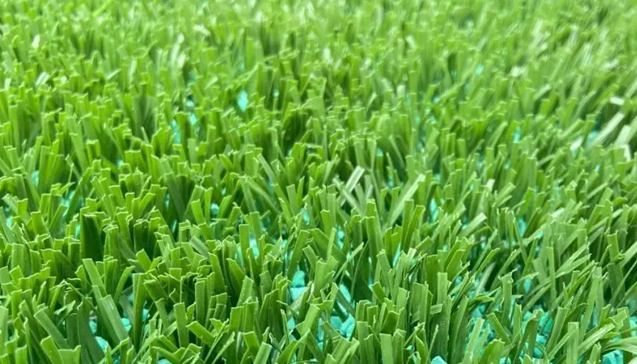With the development of the sports industry, the increasing integration of sports and education in schools, and the strengthening of people’s awareness of fitness, artificial turf sports fields have become one of the basic hardware for sports venues, sports parks, universities, middle schools, and even kindergartens. So how to create a high-quality artificial turf sports field? The quality of the site is not only related to the basic requirements such as the quality of the artificial turf itself, site slope, flatness, drainage, etc. but also has an inseparable relationship with the filling materials. In terms of site elasticity, friction, sports comfort, etc., the filling of accessories plays a crucial role.

Artificial turf-filling accessories generally refer to rubber particles and quartz sand. Accessories are the key elements of the artificial turf system. Its existence makes the establishment of system properties inevitable. At present, the most common practice in the world is to fill quartz sand and rubber particles, first filling the quartz sand, and then filling it with rubber particles.
According to the test report of FIFA, quartz sand is called stability infill, which is stability filler. Quartz sand is made of quartz and is mostly produced by washing and drying technology. It has the characteristics of high hardness, large specific gravity, uniform particle size, and small edges and corners. Since the artificial turf used in sports fields such as football fields is 40-60mm, the grass cannot be completely erected. Filling the quartz sand can not only stabilize the roots of the artificial turf grass but also make each artificial grass stand upright; The turf can also be weighted to effectively hold the turf in place without shifting. Rubber particles are performance infills, which are performance fillers, as the name suggests, ensure their sports performance. The artificial turf itself also has a certain thickness and elasticity, but in order to meet the needs of sports and to be closer to the sports effect of natural grass, it needs to be further filled with rubber particles to increase elasticity and absorb shock to prevent athletes from getting injured. The rubber particles are elastic. After filling, the rebound of the field can be better, which can minimize sports injuries and increase sports comfort. Sometimes in order to further achieve cushioning, another layer of cushioning pad is needed under the lawn. Of course, the specific filling amount should be calculated according to the needs of the site.

Rubber granules for artificial turf filling, EPDM granules, and TPE granules are commonly used in the mainstream. EPDM particles, the main component is EPDM rubber. EPDM rubber is a copolymer of ethylene, propylene, and a small amount of non-conjugated diene, which is a kind of ethylene-propylene rubber. EPDM rubber can resist ultraviolet radiation and general chemical reaction with its excellent performance, appropriate elasticity, good shock absorption performance, safety, and comfort. It can protect joints and ligaments and reduce the risk of injury. EPDM rubber granules are odorless, non-toxic, and environmentally friendly products. They are added with anti-mildew and antibacterial raw materials. They are non-flammable, stable and durable, anti-aging and resistant to acid rain, damp heat, and ozone, and are not easy to breed microorganisms. TPE particle is a new type of thermoplastic elastomer particle. Its raw material is a blend of the hydrogenated styrene-butadiene block copolymer, high polymer of ethylene and butene (POE), and other environmentally friendly polymer materials with excellent performance. It has the characteristics of high elasticity, wear resistance and anti-aging performance, high and low-temperature resistance, excellent sports performance, and environmental protection performance. It is a new high-quality auxiliary filler approved by FIFA artificial turf. An appropriate amount of rubber particles with high elastic properties are filled so that the artificial turf can effectively simulate the hardness of the soil ground, improve the surface elasticity and impact resistance of the artificial turf field, and prevent and reduce the damage caused by collision during the exercise process.
About the selection specification and filling ratio of filling materials
When artificial turf is filled with auxiliary materials, it is necessary to select qualified auxiliary materials according to the different types of sites and fill them in the correct proportion. If the field is filled randomly and blindly, not only will it not improve the sports performance of the artificial turf sports field, it may also reduce the service life of the field and cause injuries to players. In order to meet the mechanical properties of the court and at the same time play a role in protecting the athletes, it is necessary to purchase and fill in accordance with the specified standards.
The selection of quartz sand should be based on the following criteria: 1. The particle material is excellent, and the commonly used specifications are 40-60 mesh. In the actual construction of artificial turf sites, quartz sand with different specifications and meshes should be selected according to the type of site; 2. Particles are Uniform and round without sharp edges and corners, and the roundness is not less than 80%; 3. The surface of quartz sand is clean without dust and cracks, and has strong wear resistance and corrosion resistance; 4. The moisture content is less than 1‰.
Selection criteria of rubber particles: 1. Select environmentally friendly elastic rubber particles with dense rubber particles and high rubber content. According to the new national standard, the high polymer content is not less than 20%; 2. The particle size of the rubber particles is 1-3mm, which is a Triangular rhombus or regular shape; 3. Good particle material has good elasticity, is clean, and has no dust, the production process is shear type or extrusion type, with no oily rubber particles.
The filling depth of the auxiliary materials of artificial turf depends on the height of the turf and the performance required by the field. Generally, the height of the football field turf is between 40-60mm. According to the 50mm grass height used by the FIFA football field standard, the height of the filling materials is 3/4, that is, 36mm (about ±1mm), which is in line with the elasticity of the field to the football and the hardness of the surface. If it is a sports field of primary and secondary schools, accessories can be added appropriately, and it can even be equal to the grass silk. Therefore, not all sites have the same depth of filling materials, and they are filled proportionally according to different sites and grass silk heights.
The filling ratio of artificial turf accessories needs to be filled according to different types of sites. For sports with high impact strength, such as football fields, rugby fields, etc., the reference ratio of filling quartz sand and rubber particles is 40% quartz sand and 60% rubber particles, which can increase the cushioning performance of the court and reduce the sports injury of players. For sports fields with relatively small impact strength, such as tennis courts, gate courts, etc., the filling ratio can be reduced accordingly, and the field can be kept flat.
Precautions for filling construction with auxiliary materials
When filling the artificial turf sports field, the quartz sand and rubber particles must be filled in two layers and cannot be mixed. The bottom layer is filled with quartz sand and the surface layer is filled with rubber particles.
Quartz sand paving:
Paving of rubber granules:

Notes